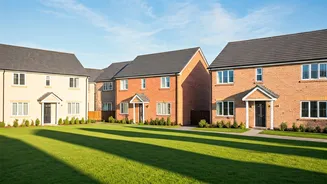Premium Explained
Understanding the 9.4% premium in the Midwest housing market requires a close examination of its components. The premium represents the difference between
the initial listing price of a property and the eventual selling price. This value fluctuates due to a variety of factors, including supply and demand, the current state of the economy, and the unique characteristics of specific properties or locales. When this premium rises, it suggests a market where demand outstrips the available supply, and this allows sellers to demand higher prices. Conversely, a decrease in the premium might signal a market with a more balanced supply and demand scenario, or even one that favors buyers. This premium is a crucial metric, as it reveals the market's trajectory and can guide both buyers and sellers in making informed decisions.
Factors Driving Premium
Multiple factors converge to influence the Midwest's housing market and the 9.4% premium. One key driver is the availability of inventory. If there's a restricted number of homes available, especially in sought-after areas, this can drive prices up. Moreover, the interest rate environment plays a pivotal role; lower rates usually stimulate demand, allowing higher purchase prices, and therefore the premium increases. Economic health is also a factor; when the economy is thriving, with high employment rates and robust income growth, more people are likely to buy homes, causing prices to elevate. Another important consideration is local population trends and migration patterns. Regions experiencing an influx of new residents typically witness increased demand, pushing up prices and the associated premium. Finally, any specific property enhancements or unique features can add to the appeal and lead to an increase in the listing price.
Impact on Buyers
The 9.4% premium has specific implications for buyers in the Midwest. Firstly, it necessitates a larger upfront financial commitment. Buyers will need to be prepared to pay more than the listed price, which could impact their savings, and they may have to adjust their budgets and possibly seek larger loans or make larger down payments. This increased cost also raises the barrier to entry, particularly for first-time buyers or those with limited financial resources, making it tougher for them to step onto the property ladder. In addition, the premium may lead to a more competitive market environment, where buyers face more competition from others, potentially leading to bidding wars and expedited decisions. This could also increase the necessity for buyers to conduct thorough market research and have their financing ready to secure their preferred property in a timely manner. Considering all aspects is vital.
Impact on Sellers
Sellers in the Midwest benefit from the 9.4% premium as it provides them with an opportunity to realize higher profits from the sale of their properties. They are likely to receive offers that are closer to or even above the asking price, increasing their potential returns. This favorable market condition can also speed up the selling process, as properties are often sold quickly, reducing the time they spend on the market. Furthermore, a rising market can empower sellers to negotiate for better terms, such as favorable closing dates or fewer contingencies. However, sellers should also be mindful of market dynamics and trends. For example, overpricing a property in the face of a slowing market can cause it to linger on the market, potentially deterring buyers. They must understand the current trends in their area to position their properties strategically. Seeking professional advice from real estate experts is also important in this scenario.
Market Outlook
Predicting the future of the Midwest's housing market requires a look at several factors. Current data indicates a 9.4% premium over the listing price, and this is dependent on interest rates, economic stability, and population migrations. If interest rates were to increase, this could possibly reduce demand and soften the premium. Economic challenges, like a decline in employment or a recession, can negatively impact market conditions, leading to a decrease in the premium. Conversely, if the Midwest sees continued population growth and economic development, the demand for housing could increase, maintaining or even raising the premium. The future of the housing market will also be determined by developments in the economy and interest rates, and changes in the inventory of available homes, and the evolution of the overall financial landscape.














